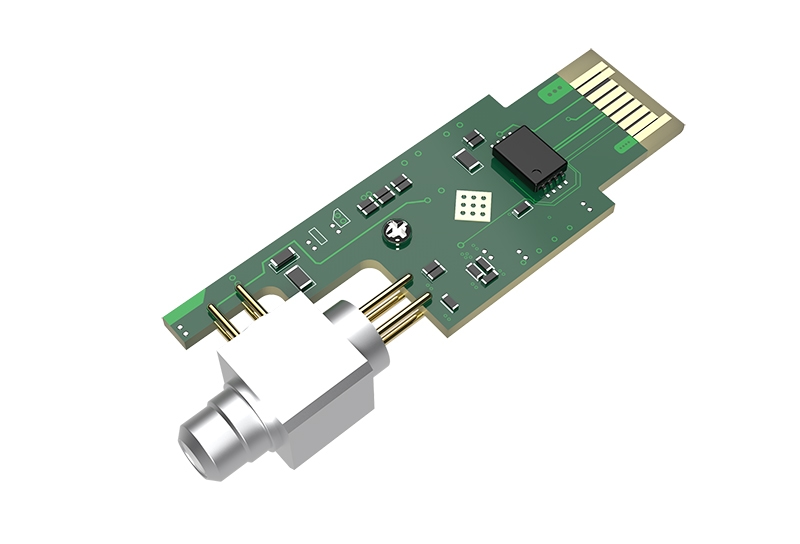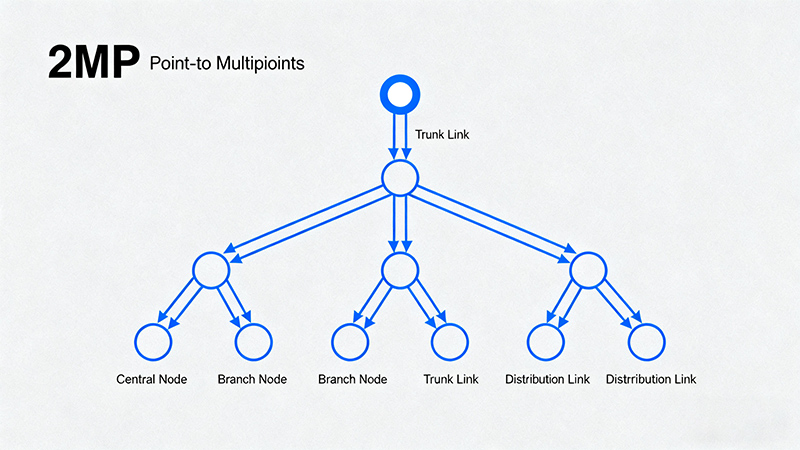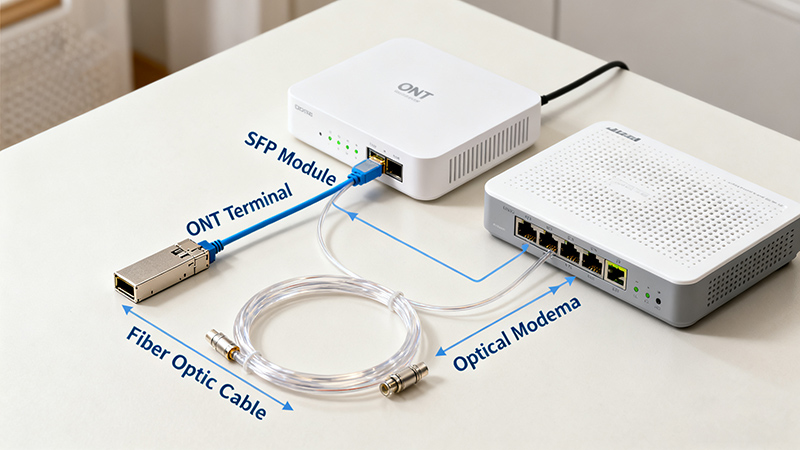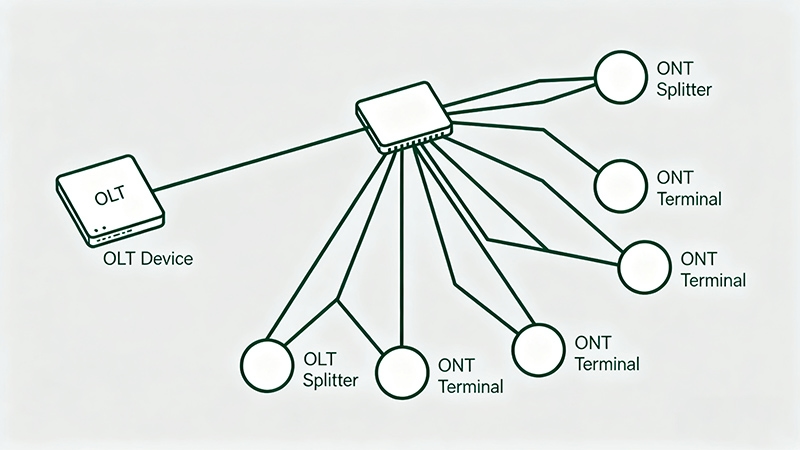Ultimate Guide to GPON SFP: The Core of Optical Access in Carrier FTTx Networks

Fiber to the X (FTTx) networks are under increasing pressure from the growing demand for bandwidth and a shifting, more complicated, and even disturbing cable plant. Resolving the issue requires advanced technology that delivers scalable and effective optical access. GPON SFP modules emerge as the fundamental solution that allows a simple and efficient point-to-multipoint connection, maximizing performance. An exploration into their technical principles, deployment approaches, and future innovations identifies how they are becoming the backbone of carrier-grade FTTx networks, allowing operators to deliver reliable and fast optical access simply and with more flexibility.
What Makes GPON SFP the Heart of FTTx Networks?
GPON SFP modules are the bedrock of point-to-multipoint (P2MP) optical access technology, which has dramatically improved FTTx optical access. GPON SFP modules differ from standard SFP modules because, rather than point-to-point links, a GPON SFP connects an Optical Line Terminal (OLT) to multiple Optical Network Terminals (ONTs). The branch style of installation allows the bandwidth to be shared among many users in the network, which reduces the complexity and costs of the infrastructure.
This technology utilizes a time-division multiplexing (TDM) method for downstream data, sending a single high-speed signal to many subscribers. The upstream transmission, on the other hand, utilizes time-division multiple access (TDMA) techniques to give multiple ONTs permission to transmit using timed slots to share the same fiber. Using timed coordination improves network efficiency and scalability.
GPON utilizes an optical architecture that is different from other SFP modules. GPON SFP modules use passive splitters, which split the optical signal without needing power or the power supply of the customer, allowing the deployment to be flexible and energy-efficient. Standard SFP modules used for direct point-to-point transmission do not utilize passive splitters and therefore cannot be used to serve multiple subscribers on a single fiber path.
The GPON SFP module optimizes fiber use by balancing high capacity and shared access with simplification of cabling. This positioning of FTTx provides unique operation and architecture to adapt to a variety of configurations for future deployments and is firmly positioned as a carrier-grade optical network module suitable for scalability and performance.

What Roles Do ONTs, OLTs, and SFP Modules Play in GPON Networks?
In a GPON network, three elements form the backbone: the Optical Line Terminal, the Optical Network Terminal, and the SFP modules that connect them. The OLT (Optical Line Terminal) functions as the brain of the network. Located at the service provider’s central office, the OLT is responsible for managing data transmission downstream, controlling bandwidth allocations, and controlling downstream and upstream communication with many ONTs separately. While the OLT manages the downstream data, it is also responsible for coordinating upstream transmissions from subscribers.
The ONT is the device located within the customer premises. It takes the optical signals and converts them back into electrical signals for use by the user devices. The ONT is the network endpoint and is the device through which the customer accesses high-speed services, such as internet or IPTV.
The GPON SFP modules plug into the OLT, providing the optical interface between the central office equipment and the fiber network. The ONT SFP module, which may be embedded or an installed component of the customer device, provides the optical link to the network. GPON SFP and ONT SFP modules must also be compatible in order to communicate. Both modules must support the same wavelength standards and data rates; for GPON, this is typically 1310nm for upstream and 1490nm for downstream. If they do not support the same wavelengths, a loss of signal and service disruption may result.
By providing an SFP link between the OLT and ONT, both GPON components can provide an efficient, scalable optical access network. As a reliable platform for optical deployment and high-speed connectivity, this trio of components is essential to carrier-grade FTTx deployments.

How to Interpret Key Technical Parameters: Speed, Wavelength, and Power Budget?
Grasping GPON SFP specifications is critical for effective network design. The upstream speed runs at 1.25 Gbps, while the downstream speed is 2.5 Gbps, allowing for asymmetric data flow for most FTTx applications.
The wavelengths have particular jobs: the 1310 nm wavelength is for upstream from the users to the OLT, and the 1490 nm wavelength is for downstream from the OLT to the subscribers. Think of these wavelengths in comparison to a highway system with separate lanes of traffic; each lane is designated for a direction of travel, preventing collisions and keeping the signal flowing appropriately.
The optical power budget stipulates the maximum loss of signal that is acceptable between the OLT and the ONT and is generally classified as B+, C+, or C++ classifications. B+ supports shorter distances and fewer splitters, while C+ or C++ supports longer distances and more splitters. Selecting the appropriate power budget helps prevent the degradation of service due to excessive attenuation in the fiber links.
The technical specifications—speed, wavelength value, and power budget—are critical to the scalability and reliability of the network. If they meet the requirements for FTTx applications, the GPON SFP modules should meet operational needs and provide reliable optical access.
Performance Evaluation of Leading GPON SFP Modules
Selecting the right GPON SFP module depends on several critical factors: specifications, compatibility, temperature tolerance, and cost. A clear and detailed comparison of specific models enables operators to make informed decisions that best suit their network needs.
| Model | Data Rate (Gbps) | Wavelength (nm) | Power Budget | Temperature Range (°C) | Price Range (USD) | Compatibility |
| Cisco Gpon SFP GIGE | 2.5 downstream / 1.25 upstream | 1490/1310 | B+, C+ | -5 to 70 | 90-120 | Broad vendor support |
| Huawei MA5603T SFP | 2.5/1.25 | 1490/1310 | C+, C++ | -40 to 85 | 100-150 | Optimized for Huawei OLT series |
| ZTE GPON SFP ZXA10 | 2.5/1.25 | 1490/1310 | B+ | -10 to 65 | 80-110 | Multi-vendor tested |
| TP-Link TL-SM321A | 2.5/1.25 | 1490/1310 | B+, C+ | -5 to 70 | 60-80 | TP-Link OLT compatibility |
| FiberHome GPON SFP | 2.5/1.25 | 1490/1310 | B+, C+ | -10 to 70 | 70-100 | FiberHome compatible OLT |
Performance & Compatibility
- Cisco GPON SFP GIGE: The Cisco GPON SFP GIGE module is a great choice if you are looking for broad vendor support and is very feasible for mixed vendors in the network. It is compatible with many OLTs and offers a good performance/cost ratio for both urban and rural networks.
- Huawei MA5603T SFP: The Huawei MA5603T SFP is intended to work with Huawei’s OLT series, so if your network uses mainly Huawei equipment, this is clearly your best choice. The MA5603T, offering a broad temperature range of -20 to 75°C, means that this module is very useful for harsh outdoor or industrial deployments where temperature also fluctuates.
- ZTE GPON SFP ZXA10: The ZTE GPON SFP ZXA10 was the only tested offer for multi-vendor compatibility. By now, everyone is assured that the use of a multi-vendor SFP will work fine across many environments, which gives assurance to many network operators that they can find cost efficiencies in service delivery yet maintain reliability.
- TP-Link TL-SM321A: The TP-Link TL-SM321A is the right choice for price-sensitive operators. Not only is the cost point competitive, but performance is still good for indoor deployments where the deployment is stable.
- FiberHome GPON SFP: The FiberHome GPON SFP has been developed for high compatibility with FiberHome vendors. FiberHome modules claim great stability and reliability for small to medium-sized FTTx networks.
Procurement Recommendations by Use Scenario
- Urban Operators in Difficult Environments: The thermal performance of the Huawei MA5603T SFP means it should be a top choice for installation in extreme environments, including outdoor cabinets or installations in industrial environments with extreme temperature ranges.
- Research-Driven Carriers that Want Compatibility: If your operator plans to ensure compatibility across multiple vendors and plans for flexibility, the Cisco GPON SFP GIGE module is a simple choice. The Cisco GPON SFP GIGE module has broad support with many different OLT vendors, offering less interoperability risk.
- Budget-Conscious Providers in Stable Indoor Environments: The TP-Link TL-SM321A is a great module as an example of deployment and use of an SFP for an operator who just needs to get the job done in a stable indoor environment, where controlling costs or budget is a priority.
 How to Solve Multi-Vendor Compatibility Issues: Testing and Best Practices
How to Solve Multi-Vendor Compatibility Issues: Testing and Best Practices
Operators encountering GPON SFP interoperability challenges across multiple vendor modules and systems face problems that will affect network stability and cause service interruptions. This makes testing GPON SFP modules with an operator-specific test plan necessary and critical.
The continuous improvement approach begins with operators utilizing SFP compatibility assessments through CLI diagnostics. Operators use common CLI commands that check module health, lag errors, and compatibility indicators. These assessment tools are potentially helpful in determining if the GPON SFP module’s firmware is up to date with the OLT requirements.
Operators may also employ third-party code verification tools to cross-check vendor firmware versions and calibrate configuration settings. These types of third-party utilities are helpful in revealing unknown and hidden mismatches that may not be evident in procedural testing, ultimately enhancing GPON SFP interoperability.
Operator partnerships with vendors are extremely important. Operators negotiate firmware versions or monitor and recommend standardized coding implementation to ensure there is long-term consistency and performance across the network. Vendors should continually partner with their customers committed to interoperability, which is essential to reduce long-term maintenance issues caused by vendor-specific firmware modules and rein in service costs and downtime.
Establishing rigorous testing protocols with vendors provides a clear vendor partnership path into a stable, multi-vendor ecosystem. This type of proactive strategy protects the operator’s ability to deliver maximum network performance and ease of programmatic management across a diverse list of equipment sources in the FTTx Optical Access portfolio network uniformly. Practical testing of GPON SFP modules and the collaborative nature of vendor partnerships are paramount to delivering operators a functional and reliable network experience in the complex GPON environment.
How to Overcome Optical Loss, Temperature Control and Inventory Challenges?
Fiber attenuation is a frequent physical-layer challenge in GPON deployments. Too much signal loss can weaken data transmission and may disrupt service. The best way to minimize attenuation is through high-quality splicing and connectors. Good fiber cleaning and routing practices ensure signal integrity over time by preventing excessive physical tension or bend loss in optical power.
Temperature management is critically important as well. High temperatures in SFP modules can shorten the component’s lifespan and lead to unreliable performance. Devices located in small or poorly ventilated spaces may need an additional cooling device like a fan or heat sink to ensure that the components don’t overheat. Using a diagnostic tool to monitor the real-time temperature of the device could help ensure adjustments are made to keep the SFP at optimal operating conditions.
Prudent SFP inventory control practices can avoid many compatibility and performance issues with spare SFP modules. Keeping accurate lifecycle records and rotating your stock can help mitigate risks associated with outdated or incompatible components. These simple adjustments reduce repair and upgrade downtime while keeping operational costs down.
By addressing challenges with simple cabling practices, good thermal management, and consistent inventory management of spare SFPs, you can build a more stable and reliable GPON network. With best practices for maintaining the physical components, SFPs will perform better and provide consistent optical access even under more challenging conditions.

How an Operator Achieved Success in GPON SFP Deployment
A major telecom provider was often challenged with compatibility issues every time it attempted to launch GPON SFP modules with various vendors. The provider experienced unexpected downtime when firmware or protocols were out of sync with what was published by the SFP vendor. Each time downtime occurred, troubleshooting costs increased, and the ability to address problems in a timely manner became more difficult.
Once the operator established a process for SFP compatibility testing and developed a proactive partnership with the vendors, the integration process became a much more streamlined undertaking. The operator requested standardized firmware updates provided in partnership with the SFP vendor; coding practices were shared and agreed upon, which significantly reduced compatibility challenges.
Ultimately, the operator achieved a 30% improvement in deployment time and experienced 25% in cost savings due to fewer technician visits to the field. The collaboration allowed for increased network uptime, which improved subscriber satisfaction and ultimately had an impact on subscriber churn.
The operator’s experience illustrated that discipline in testing, along with vendor collaboration, fundamentally drives the real-world optimization of FTTx networks. The success of the operator’s deployment experience demonstrated the value of addressing compatibility early and consistent management during the lifecycle of deployment. The provided GPON SFP deployment case study demonstrates strategies that can be adapted by other operators to deliver stability and efficiency with optical access networks.
How Does XGS-PON SFP+ Deliver a Performance Leap Beyond Traditional GPON?
XGS-PON SFP+ changes optical access with a symmetric 10 Gbps data rate—four times the downstream rate of conventional GPON (2.5 Gbps) and eight times the upstream rate (1.25 Gbps). This advancement allows networks to handle high-bandwidth applications while maintaining speed in both directions.
As opposed to standard GPON that usually biases download traffic, the XGS-PON network offers equal upload/download throughput. This is vital for services like 5G backhaul, where instantaneous data exchange requires high-capacity throughput in both directions consistently.
Enterprise-leased lines can implement XGS-PON SFP+ modules. The 10G PON optical module models the security and dedicated bandwidth lines, replacing expensive dedicated fiber circuits with a flexible topology.
With a compact size and operational efficiency, these high-bandwidth PON modules can easily be added to already existing infrastructure, from a legacy system to support next generation data requirements without needing a full fiber upgrade. XGS-PON SFP+ combines advanced speeds and symmetrical data flows, allowing service providers to deliver resilient, scalable and cost efficient FTTx optical access solutions.
How Will Technology Convergence and Sustainability Impact GPON SFP?
The emergence of combined fixed and mobile service transport solutions for fiber access through more complete integration with 5G transport is changing the concept of fiber to the premise. The low latency and high throughput demands of 5G front and mid haul networks will further drive GPON SFP units to support the transport of both fixed and mobile data, further simplifying infrastructure and maximizing fiber utilization.
Next-generation PON specifications such as 25G and 50G will provide a substantial bandwidth leap; however, these advancements also create challenges regarding interoperability and possibly power consumption. Networks increasingly will need to balance increased performance with energy efficiency to achieve long-term sustainable optical access.
By creating GFPT SFP modules that are more modular and upgradable, ultimately providing greater flexibility, organizations can enable operators to be more resilient to changes in demand and environmental considerations. By emphasizing not just lower power consumption but also recycled materials, the overall industry is participating in the reduction of carbon footprints.
The convergence of technologies, along with the changing priorities of sustainability, will drive further innovation to ensure that GPON SFP modules not only deliver more speed but add responsible, long term value. Embracing this convergence of faster speeds and eco-sustainability creates resiliency in FTTx networks for the advancing digital landscape.

Conclusion
GPON SFP modules are the foundation of effective FTTx networks that provide scalable, high-performance optical access. Their specific capability of supporting point to multipoint architecture, combined with the important factors of speed, wavelength, and power budget, provides robust fiber connectivity.
Understanding the elements of compatibility management and deployment practices is critical for network performance reliability and cost conservation. With an emphasis on proper testing and vendor engagement, service providers can limit downtime and optimize performance.
Proper fiber access planning requires understanding the GPON SFP modules’ technical basics and matching them with evolving service requirements. Understanding the GPON SFP modules will put engineers in a position to implement, operate, and upgrade their network with confidence.
Understanding GPON SFP modules is an important step for developing FTTx networks that are future-ready and able to support new technologies while sustaining a proven level of service quality.

 How to Solve Multi-Vendor Compatibility Issues: Testing and Best Practices
How to Solve Multi-Vendor Compatibility Issues: Testing and Best Practices